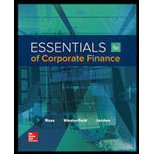
Concept explainers
To calculate: The
Introduction:
Rate of return refers to the gain or loss on the investment. It also refers to the increase or decrease in the capital value of an investment.
Answer to Problem 4QP
The rate of return is as follows:
| Particulars |
Present value |
Years |
Interest Rate |
Future value |
| Investment A | $715 | 11 | 6.17% | $1,381 |
| Investment B | $905 | 8 | 8.34% | $1,718 |
| Investment C | $15,000 | 23 | 10.26% | $141,832 |
| Investment D | $70,300 | 16 | 9.78% | $312,815 |
Explanation of Solution
Given information:
Investment A has a present value of $715,
Investment C has a present value of $15,000, future value of $141,832, and a 23-year investment period. Investment D has a present value of $70,300, future value of $312,815, and a 16-year investment period.
The formula to calculate the rate of return:
Where,
“P” refers to the principal amount invested
“r” refers to the rate of interest or return
“t” refers to the number of years or periods of investment
“FV” refers to the future value or the current market value
Compute the rate of return of Investment A:
Hence, the rate of return of Investment A is 6.17%.
Compute the rate of return of Investment B:
Hence, the rate of return Investment B is 8.34%.
Compute the rate of return of Investment C:
Hence, the rate of return Investment C is 10.26%.
Compute the rate of return of Investment D:
Hence, the rate of return Investment D is 9.78%.
Want to see more full solutions like this?
Chapter 4 Solutions
ESSENTIALS CORPORATE FINANCE + CNCT A.
- Inferior Investment Alternatives Although investing requires the individual to bear risk, the risk can be controlled through the construction of diversified portfolios and by excluding any portfolio that offers an inferior return for a given amount of risk. While this concept seems obvious, one of your clients, Laura Spegele, is considering purchasing a stock that you believe will offer an inferior return for the risk she will bear. To convince her that the acquisition is not desirable, you want to demonstrate the trade-off between risk and return. While it is impractical to show the trade-off for all possible combinations, you believe that illustrating several combinations of risk and return and applying the same analysis to the specific investment should be persuasive in discouraging the purchase. Currently, U.S. Treasury bills offer 2.5 percent. Three possible stocks and their betas are as follows: 1. What will be the expected return and beta for each of the following portfolios? a.…arrow_forwardSolve this fin. Qn no aiarrow_forwardYou gave me unhelpful so i also gave you unhelpful.arrow_forward
- What is corporate finance? how many types of corporate finance??arrow_forwardEsfandairi Enterprises is considering a new three-year expansion project that requires an initial fixed asset investment of $2,350,000. The fixed asset will be depreciated straight-line to zero over its three-year tax life, after which time it will be worthless. The project is estimated to generate $3,310,000 in annual sales, with costs of $2,330,000. Assume the tax rate is 23 percent and the required return on the project is 11 percent. What is the project's NPV? Note: A negative answer should be indicated by a minus sign. Do not round intermediate calculations and round your answer to 2 decimal places, e.g., 32.16.arrow_forwardGyygvvv iiiedfarrow_forward
 EBK CONTEMPORARY FINANCIAL MANAGEMENTFinanceISBN:9781337514835Author:MOYERPublisher:CENGAGE LEARNING - CONSIGNMENT
EBK CONTEMPORARY FINANCIAL MANAGEMENTFinanceISBN:9781337514835Author:MOYERPublisher:CENGAGE LEARNING - CONSIGNMENT Pfin (with Mindtap, 1 Term Printed Access Card) (...FinanceISBN:9780357033609Author:Randall Billingsley, Lawrence J. Gitman, Michael D. JoehnkPublisher:Cengage Learning
Pfin (with Mindtap, 1 Term Printed Access Card) (...FinanceISBN:9780357033609Author:Randall Billingsley, Lawrence J. Gitman, Michael D. JoehnkPublisher:Cengage Learning


